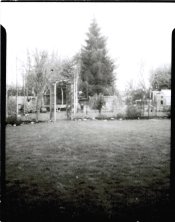Moizak
Member
- Joined
- Feb 17, 2012
- Messages
- 11
- Format
- Multi Format
(I have also posted this in the Paper Negatives group)
Hello guys, first time posting!
Well, here are my two very first images produced with my homemade pinhole camera and Harman positive paper. Now, I know these are not great so I wanted to post them up and get some advice.
From my understanding, these have been overexposed. These are the factors I am assuming can have affected this:
1) My pinhole size is actually larger than I think it is. (It is approx .5mm which is what I used to calculate my f-stop. Focal length is 120mm so camera is f240). I might change the estimation to .55mm or .6mm
2) The darker portrait oriented image used a digital meter in incedent mode. I set an EI of 3 for the paper and used an online chart to convert the 1sec f8 it gave me to 15mins 18sec at f240
3) The lighter lanscape oriented image was metered using an iPhone app and my iPhone as the light meter. This gave me an exposure of 41 mins!
They were both developed in Ilford PQ at 1:15 for 3 mins at 20degC ( I got this from another post on a forum, not sure who but his pics were great so seemed worth copying)
Is this simply a case of getting my pinhole size wrong? What would be the best scientific method to getting a decent image out of my pinhole camera?
Thanks all in advance.
M


Hello guys, first time posting!
Well, here are my two very first images produced with my homemade pinhole camera and Harman positive paper. Now, I know these are not great so I wanted to post them up and get some advice.
From my understanding, these have been overexposed. These are the factors I am assuming can have affected this:
1) My pinhole size is actually larger than I think it is. (It is approx .5mm which is what I used to calculate my f-stop. Focal length is 120mm so camera is f240). I might change the estimation to .55mm or .6mm
2) The darker portrait oriented image used a digital meter in incedent mode. I set an EI of 3 for the paper and used an online chart to convert the 1sec f8 it gave me to 15mins 18sec at f240
3) The lighter lanscape oriented image was metered using an iPhone app and my iPhone as the light meter. This gave me an exposure of 41 mins!
They were both developed in Ilford PQ at 1:15 for 3 mins at 20degC ( I got this from another post on a forum, not sure who but his pics were great so seemed worth copying)
Is this simply a case of getting my pinhole size wrong? What would be the best scientific method to getting a decent image out of my pinhole camera?
Thanks all in advance.
M





















